List of Contents
Intravenous (IV) Hydration Therapy Market Size and Forecast 2025 to 2034
The global intravenous (IV) hydration therapy market size was calculated at USD 2.71 billion in 2024 and is projected to surpass around USD 5.84 billion by 2034, expanding at a CAGR of 7.98% from 2025 to 2034. The intravenous (IV) hydration therapy market is driven by the rising demand for preventative and wellness services.
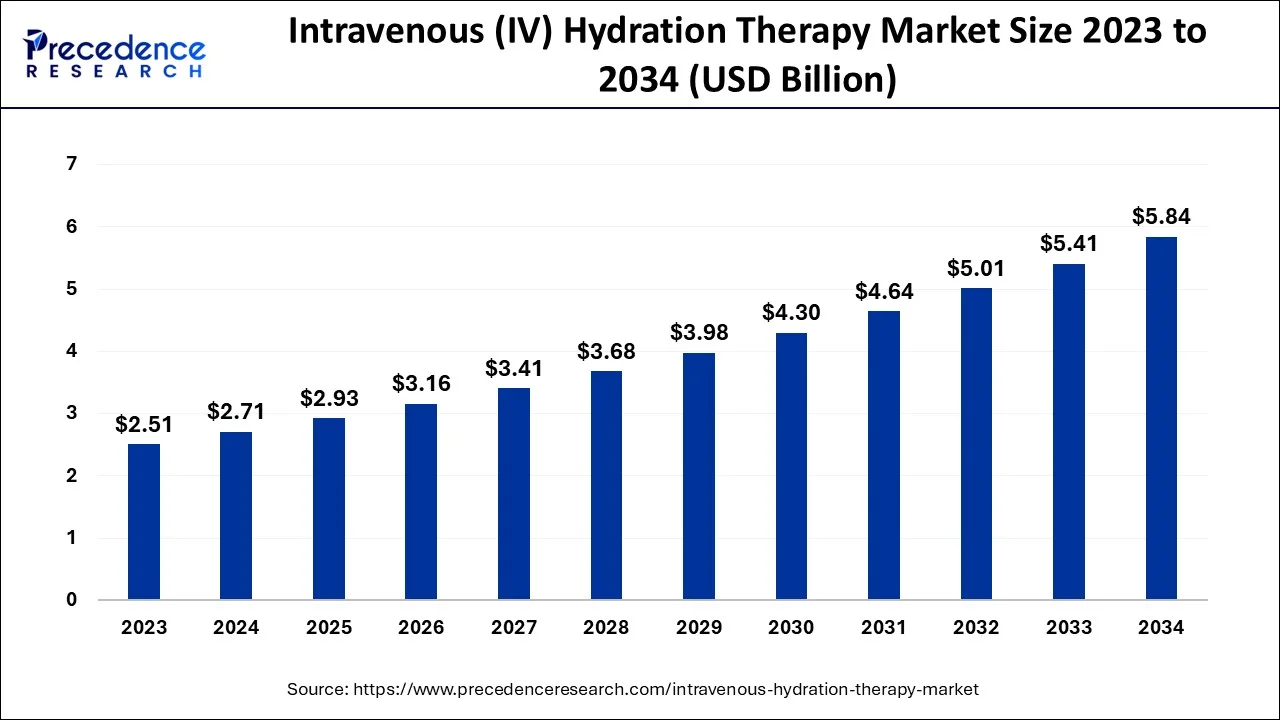
Intravenous (IV) Hydration Therapy Market Key Takeaways
- In terms of revenue, the intravenous (IV) hydration therapy market is valued at $2.93 billion in 2025.
- It is projected to reach $5.84 billion by 2034.
- The intravenous (IV) hydration therapy market is expected to grow at a CAGR of 7.98% from 2025 to 2034.
- North America dominated the intravenous (IV) hydration therapy market with the largest market share of 47% in 2024.
- Asia Pacific is observed to host the fastest-growing market during the forecast period.
- By service, the energy boosters segment accounted for the highest market share of 27% in 2024.
- By service, the skin care segment is observed to witness the fastest growth in the market during the forecast period.
- By component, the medicated segment has held the major market share of 68% in 2024.
- By component, the non-medicated segment is observed to grow rapidly in the market during the forecast period.
- By end-use, the hospitals and clinics segment contributed the biggest market share of 44% in 2024.
- By end-use, the home healthcare segment is observed to expand significantly in the market during the forecast period.
How is AI Helping the Intravenous (IV) Hydration Therapy Market Grow?
Artificial Intelligence (AI) has huge potential to revolutionize medicine and patient care in the intravenous (IV) hydration therapy market. By sorting through mountains of data, identifying trends, and making accurate predictions, AI can speed up the development of new medicines and enhance trial design, safety monitoring, patient recruitment and selection, and drug discovery. It holds promise for advancing customized medicine and more potent treatments by streamlining processes, cutting expenses, and increasing efficiency. This will help the business in enhancing its AI for diagnosis, treatment, and drug discovery.
- In March 2022, NVIDIA Corporation unveiled the Clara Holoscan MGX, a tool for creating and utilizing real-time AI applications. To accelerate innovation in the medical device sector, Clara Holoscan MGX extends the Clara Holoscan platform to provide a comprehensive, medical-grade standard design and long-term software support.
U.S. Intravenous (IV) Hydration Therapy Market Size and Growth 2024 to 2034
The U.S. intravenous (IV) hydration therapy market size was exhibited at USD 1.11 billion in 2024 and is anticipated to reach around USD 2.43 billion by 2034, growing at a CAGR of 8.15% from 2025 to 2034.
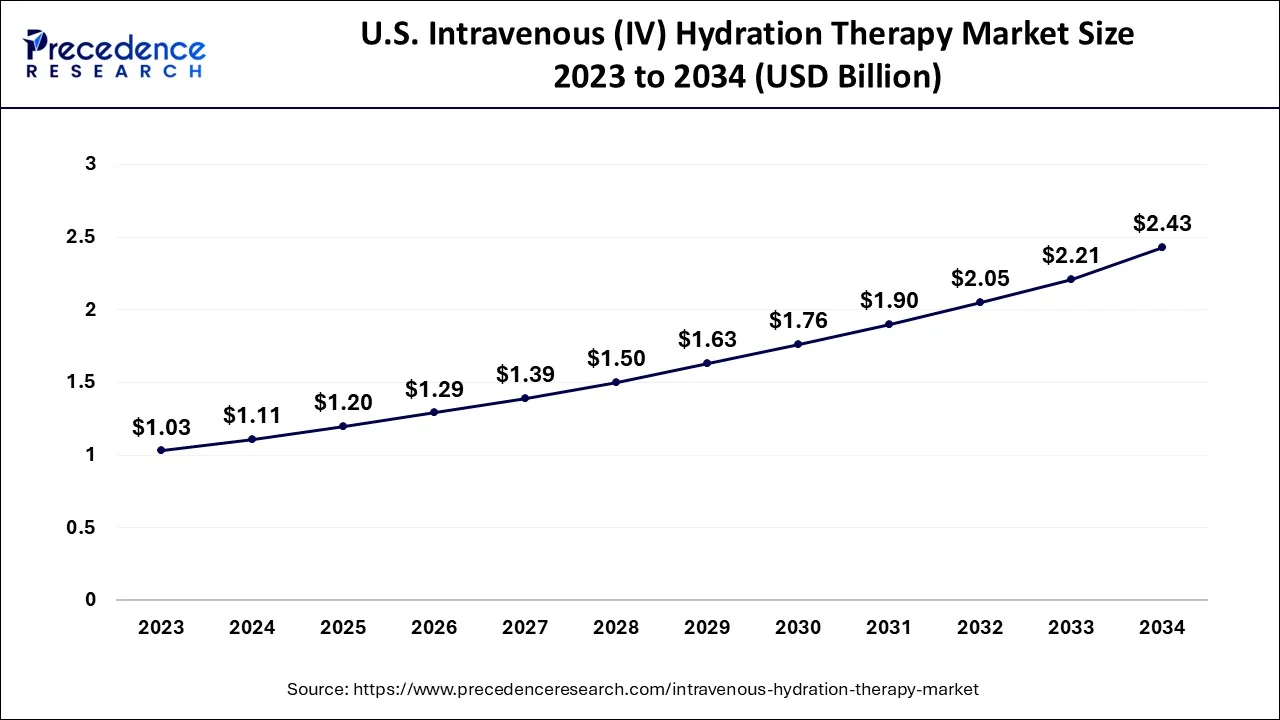
North America dominated the intravenous (IV) hydration therapy market in 2024. The demand for health and wellness services has increased recently in North America, particularly in the U.S. IV hydration therapy is becoming increasingly popular for uses like immune building, anti-aging, recuperation, and sports performance. IV therapy is now a well-liked choice for people looking for rapid health boosts because it has gained widespread acceptability as a treatment for conditions like weariness, jet lag, hangovers, and dehydration.
North America continues to dominate the IV hydration therapy market, driven by growing health awareness, medical infrastructure, and a cultural shift toward preventive care. The United States stands out as a key contributor due to its early adoption of wellness-focused IV clinics. Several U.S. states have updated their healthcare laws to permit licensed nurses and paramedics to administer IV hydration in non-traditional settings, including homes and events. Public health departments have also launched campaigns on safe and sterile IV administration, further fuelling trust in these services.
The United States is home to hundreds of boutique IV therapy clinics, especially in cities like Los Angeles, Miami, and New York. The U.S. boasts a massive customer base and an innovation-led ecosystem. The FDA's flexible approach towards non-hospital use of IV fluids has helped private players thrive. On the other hand, Canadian clinics are increasingly offering IV vitamin therapy for chronic fatigue, stress, and immune health, supported by public interest in alternative medicine.
- IV hydration services are becoming increasingly common in corporate wellness programs as part of employee health benefits, particularly for businesses that prioritize worker productivity and well-being. Due to this corporate interest, IV services now have a stable and growing market base.
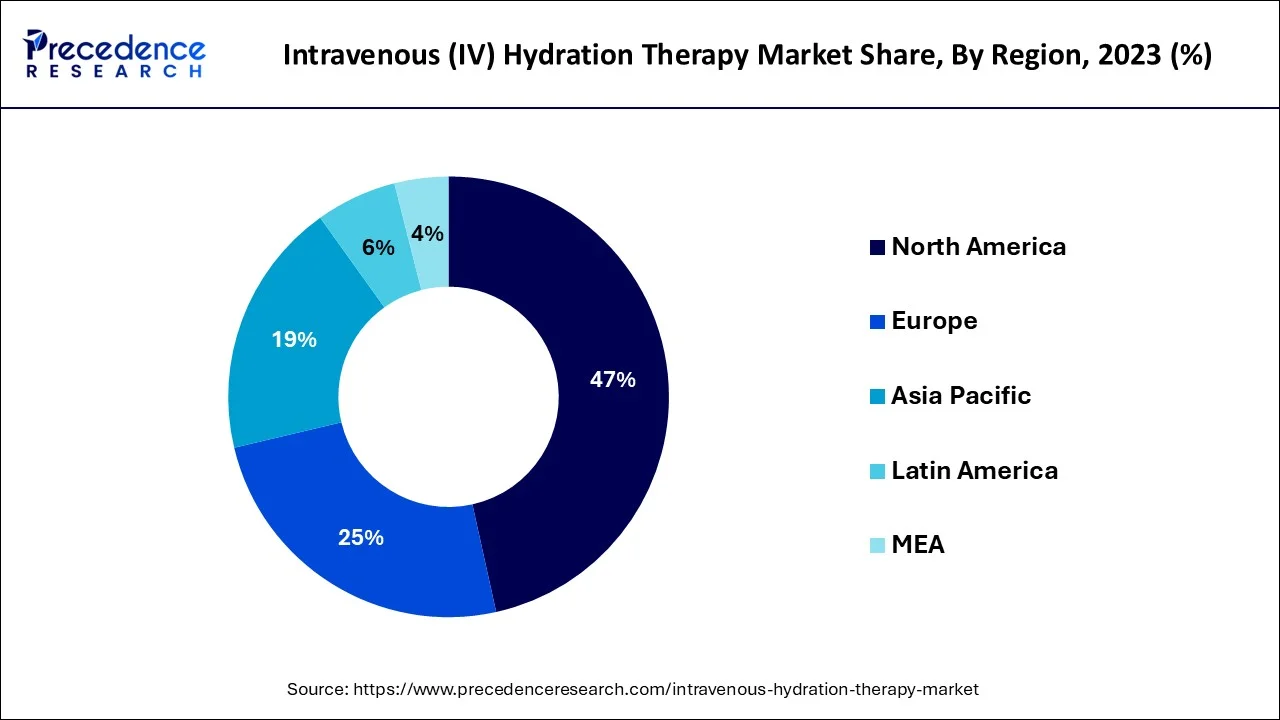
Asia Pacific is observed to host the fastest-growing intravenous (IV) hydration therapy market during the forecast period. IV hydration therapy is becoming increasingly popular as people become more conscious of their health and well-being. The advantages of IV therapy, such as hydration, food replenishment, and recovery support, are becoming more widely known. IV hydration therapy is becoming more common in alternative medicine clinics, wellness centers, and spas throughout Asia-Pacific. These establishments provide both residents and visitors hydration therapy for detoxification, anti-aging, and wellness.
Asia Pacific is emerging as the fastest-growing region in the IV hydration therapy market, thanks to a booming middle class, heightened health awareness, and increased adoption of wellness practices. Countries such as India, China, South Korea, Japan, and Thailand are witnessing rapid expansion in both medical and non-medical IV therapy services.
- A number of regional governments are investing in healthcare services and infrastructure to increase access to therapies, such as intravenous hydration. For example, in China, continuous efforts are underway to improve access to cutting-edge therapies and modernize healthcare facilities.
Market Overview
IV hydration therapy has seen a sharp increase in interest and demand as a supportive treatment for viral illnesses since the COVID-19 pandemic brought attention to the significance of immune support and hydration. A little IV is inserted into the arm to provide fluids directly into the bloodstream as part of the simple intravenous (IV) hydration therapy technique. Enabling the body to absorb nutrients, blood, water, and drugs more rapidly through the circulatory system aids in treatment. Preventive healthcare practices, such as hydration treatment, which helps preserve general health and avoid issues linked to dehydration, have increased in popularity due to growing awareness of health and wellness.
Intravenous (IV) Hydration Therapy Market Growth Factors
- There is a growing need for convenient wellness products as consumers become more conscious of preserving hydration and nutrient levels. The intravenous (IV) hydration therapy market is expanding as IV treatment is used for wellness supplements, vitamin infusion, and hydration.
- The trend toward personalized medicine and preventative healthcare has made customers more inclined to spend money on treatments that preserve health and avert future ailments. IV treatment's adaptable approach to health maintenance increases its acceptance and uptake.
- IV therapy has benefited from technological advancements that have simplified processes and improved safety, such as more portable and user-friendly equipment. This expands the market by making it simpler for suppliers to offer services in a greater range of contexts.
Market key trends: A wellness revolution in a dip
The intravenous hydration therapy market is witnessing a paradigm shift from hospital-based treatments to wellness and lifestyle-oriented services. Once limited to emergency and clinical care, IV therapy has now made its way into spas, wellness centers, and even home-based setups. Celebrity and influencer endorsements, social media visibility have helped in normalizing and glamorizing wellness therapy, making it more mainstream.
Key trends shaping the market include rising demand for wellness and anti-aging solutions among consumers is increasing the demand for IV therapies for quick energy boosts, immune support, and skin rejuvenation. Popularity of mobile IV services, convenience-driven offerings like home visits, and concierge services are expanding, especially in urban areas. Tech-driven appointments and tracking digital booking platforms and mobile health apps now allow users to schedule treatments and track their health data in real-time.
Market Scope
| Report Coverage | Details |
| Market Size by 2034 | USD 5.84 Billion |
| Market Size in 2024 | USD 2.71 Billion |
| Market Size in 2025 | USD 2.93 Billion |
| Market Growth Rate from 2025 to 2034 | CAGR of 7.98% |
| Largest Market | North America |
| Base Year | 2024 |
| Forecast Period | 2025 to 2034 |
| Segments Covered | Service, Component, End-Use, and Regions |
| Regions Covered | North America, Europe, Asia-Pacific, Latin America and Middle East, & Africa |
Market Dynamics
Driver
Increasing health awareness
People's awareness of the need to stay hydrated for general health is growing as they become more health conscious. The need for IV hydration therapy has grown due to awareness campaigns regarding the advantages of maintaining proper hydration, including higher energy, healthier skin, and improved cognitive function. Restoring fluids, electrolytes, and vitamins is a speedy and efficient treatment.
Regulatory agencies set rules and safety requirements for IV hydration therapy as demand and awareness grow. Because of the increased consumer confidence this regulatory support brings, more people are inclined to attempt IV hydration as a secure and efficient medical intervention.
Restraint
Regulatory challenges
To approve intravenous (IV) hydration therapy market products, regulatory bodies like the FDA in the US and the EMA in Europe have strict requirements. Clinical trials and follow-up assessments can take a long time, delaying market entry and raising expenses. Manufacturers are required to adhere to strict GMP rules that demand strict quality control procedures. Ensuring compliance can be expensive and resource-intensive, especially for small and medium-sized businesses. Businesses must set up guidelines for monitoring and disclosing unfavorable incidents linked to their goods, which can be complex and resource-intensive, mainly for companies with weak infrastructure.
Opportunity
Innovations in IV therapy products
Real-time infusion rate and volume monitoring are possible with smart IV pumps equipped with sophisticated algorithms and software. By lowering the possibility of human error, these pumps guarantee precise drug administration and minimize side effects in the intravenous (IV) hydration therapy market. Healthcare practitioners can more easily monitor patient development by integrating with electronic health records (EHRs), simplifying data administration.
Alerts for any problems can be sent out instantly by combining real-time monitoring systems that keep track of vital signs and infusion parameters in the intravenous (IV) hydration therapy market. The need for cutting-edge IV therapy products is increased by this capability, which also lowers hospital stays, enhances patient safety, and facilitates proactive therapeutic interventions.
Service Insights
The energy boosters segment dominated the intravenous (IV) hydration therapy market in 2024. Preventive care, wellness, and health are becoming increasingly important to consumers. IV hydration treatments, especially energy boosters, are preferred by many people looking for quick and efficient ways to increase their energy levels. The demand for IV energy boosters, which promise rapid regeneration and energy restoration, is propelled by this increased awareness and proactive attitude to wellbeing. IV treatment enables direct nutrient absorption into the bloodstream, offering quicker, more pronounced results than oral hydration and supplements. Energy boosters are more popular because of this effective delivery system, especially among people who want immediate effects. The immediate benefits are viewed as advantageous before essential occasions, during physical activity, or after high physical exertion.
The skin care segment is observed to witness the fastest growth in the intravenous (IV) hydration therapy intravenous (IV) hydration therapy market during the forecast period. It is becoming increasingly popular since IV hydration therapy is thought to provide skincare benefits like increased hydration, collagen stimulation, and fewer fine lines. IV treatments send nutrients straight into the circulation, producing more immediate and significant results than standard skincare products used topically. This has drawn those who want to see noticeable changes in the texture and appearance of their skin. More people can now access these therapies because of the growth of wellness clinics and med spas that provide personalized IV treatments. To meet the rising need for skincare-specific IV treatments focusing on hydration, anti-aging, and skin brightening, clinics are increasingly providing these services.
- The Glutathione Glow Drip, a state-of-the-art treatment for improved skin brightness, is currently offered by IV DRIPS in New York City and other places. With customized IV therapy, this new procedure provides a quick and efficient means of achieving a glowing complexion.
Component Insights
The medicated segment held the largest share of the intravenous (IV) hydration therapy market in 2024. Around the world, the prevalence of chronic diseases like cancer, renal disease, and gastrointestinal disorders has been rising. Because patients may have trouble absorbing nutrients in conventional ways, these illnesses frequently need regular hydration and nutritional supplementation. Wellness-conscious consumers looking for quick and noticeable results are very interested in products that contain antioxidants, collagen-boosting agents, and moisturizing components.
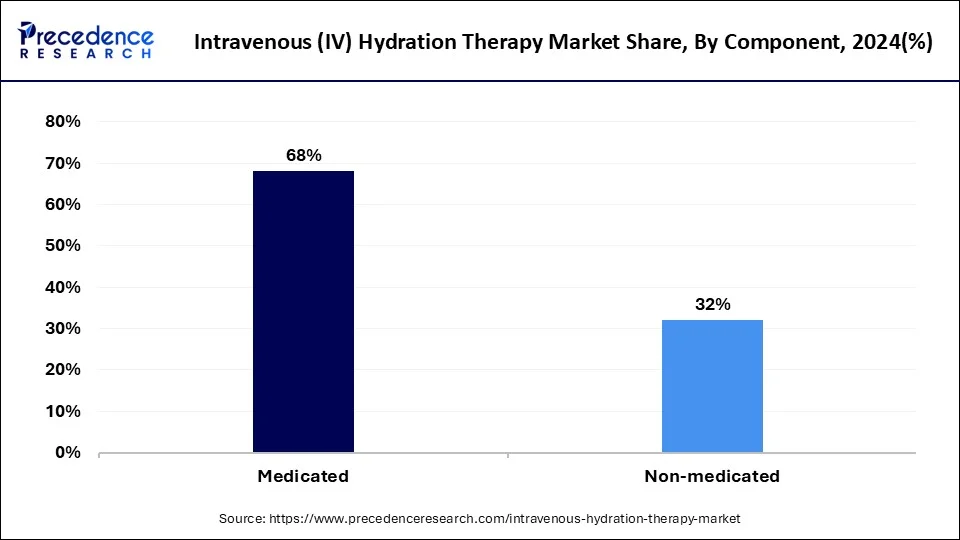
The non-medicated segment is observed to grow rapidly in the intravenous (IV) hydration therapy market during the forecast period. Customers are pursuing non-medicated IV therapies that promote hydration, vitamin replenishment, and detoxification without the use of pharmaceuticals as a result of their growing desire for preventive health measures. This pattern fits perfectly with the general consumer preference for self-care and wellness, and the regulatory barriers are frequently lower for these therapies because they don't involve drugs, making it possible for more providers to enter the market and offer a wider variety of IV choices that cater to specific wellness and health requirements.
End-Use Insights
The hospitals & clinics segment dominated the global intravenous (IV) hydration therapy market in 2024. Hospitals and clinics have hygienic surroundings and extensive healthcare facilities for IV hydration therapy to be effective. These tools guarantee that hydration therapy is administered effectively, safely, and with the capacity to handle any potential consequences. Given the growing need for hydration therapy for disorders like dehydration, electrolyte imbalance, and the management of chronic illnesses, hospitals, and clinics have infrastructure designed to handle large patient volumes.
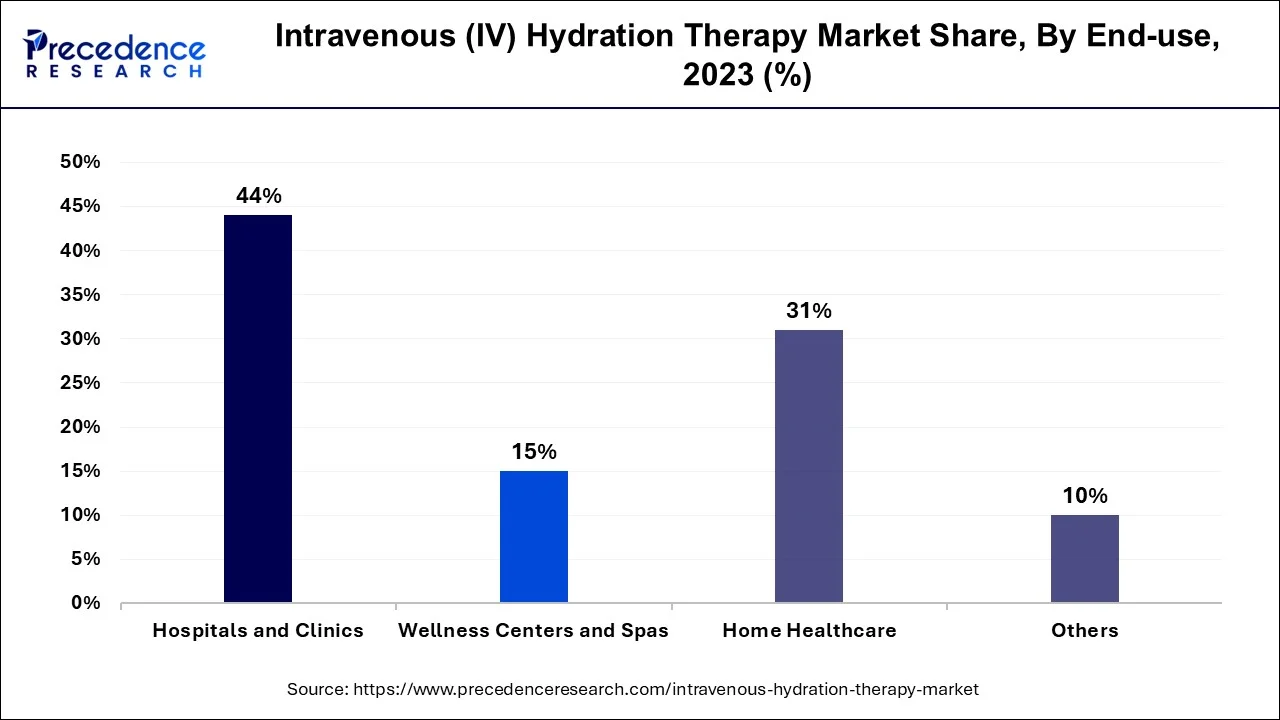
The home healthcare segment is observed to expand significantly in the intravenous (IV) hydration therapy market during the forecast period. At-home medical services are in high demand as healthcare moves toward patient-centric models. A more individualized healthcare experience is made possible by the fact that patients frequently opt to get IV hydration therapy in the convenience of their own homes, which lowers hospital stays and lengthy wait periods. As patients grew more wary of hospital-acquired infections, the pandemic increased the need for home-based care. Particularly, patients with weakened immune systems started to prefer at-home therapies, such as intravenous hydration.
Intravenous (IV) Hydration Therapy Market Companies
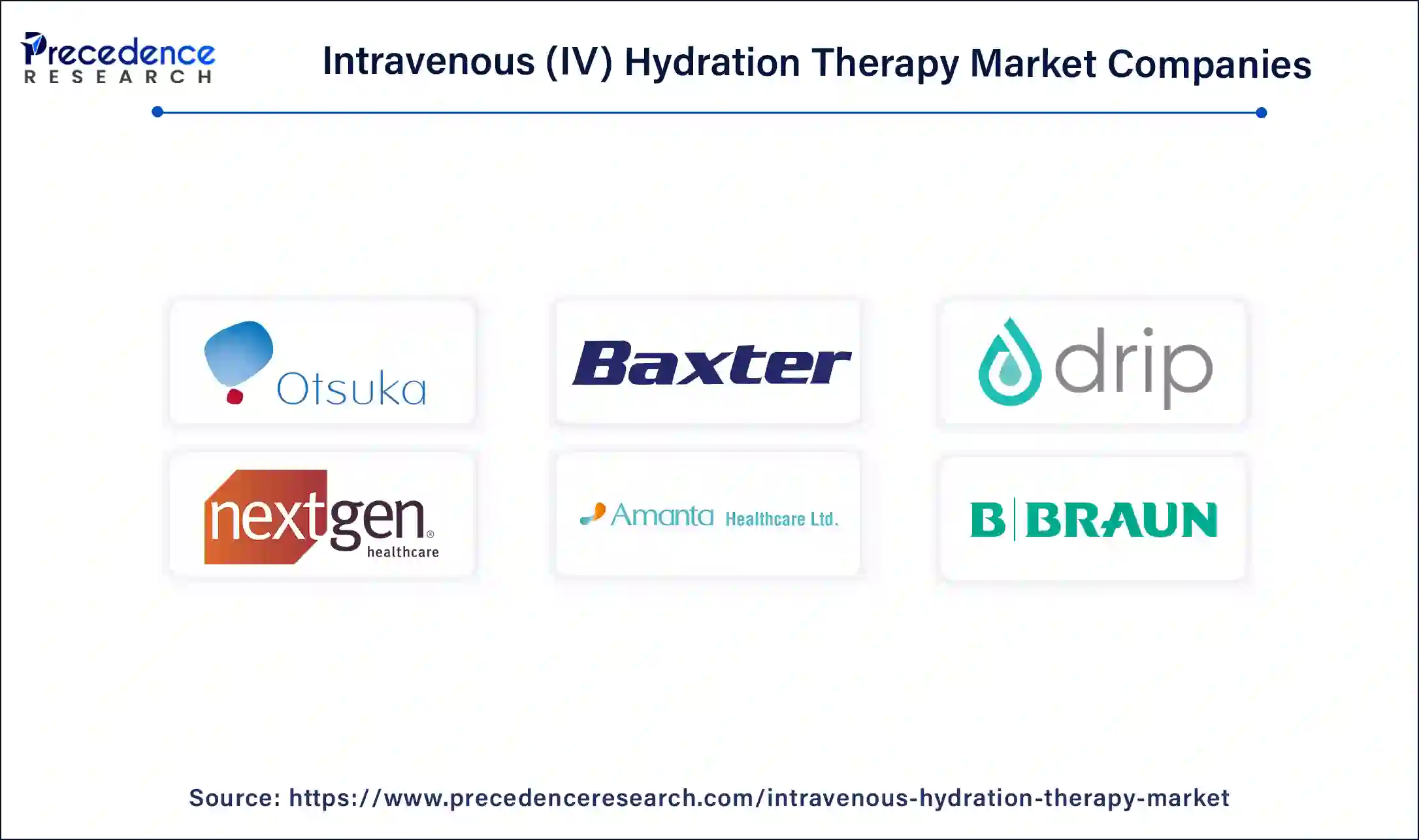
- Core IV Therapy, LLC
- Otsuka Pharmaceutical Co., Ltd.
- Baxter International Inc.
- Drip Hydration
- NexGen Health
- JW Life Science Corporation
- Amanta Healthcare
- Cryojuvenate UK Ltd.
- B. Braun Medical Inc.
Recent Developments
- In May 2025, India's Lifedrip Healthcare launched a chain of mobile IV hydration vans in Mumbai and Bangalore, aiming to serve on-the-go professionals and athletes seeking immunity and energy boosts.
- In May 2025, Japan's Medi Flow Corp unveiled a new smart IV monitoring system integrated with wearable trackers that notify hydration levels and suggest custom drips in real-time.
- In June 2024, ChromaDex unveiled Niagen+, a pharmaceutical-grade injectable and intravenous version of Niagen, the business's proprietary nicotinamide riboside (NR) NAD+ precursor.
- In April 2024, the intravenous (IV) infusion formulation of Fycompa (perampanel hydrate), an antiepileptic medication (AED) that Eisai Co., Ltd. developed in-house, was introduced in Japan.
- In May 2022, according to Roche Pharma, the world's first fixed-dose formulation of two monoclonal antibodies for the treatment of cancer, PHESGO, was launched in India.
Hydration Therapy Market Major Announcements
To establish a new company specializing in cutting-edge technology for the treatment of cardiac arrhythmias, Adagio Medical has announced the conclusion of its business combination with ARYA Sciences Acquisition Corp IV, a special-purpose acquisition company supported by an affiliate of Perceptive Advisors.
Segments Covered in the Report
By Service
- Immune Boosters
- Energy Boosters
- Skin Care
- Migraine
- Others
By Component
- Medicated
- Non-Medicated
By End-Use
- Hospitals and Clinics
- Wellness Centers and Spas
- Home Healthcare
- Others
By Geography
- North America
- Asia Pacific
- Europe
- Latin America
- Middle East and Africa
For inquiries regarding discounts, bulk purchases, or customization requests, please contact us at sales@precedenceresearch.com
Frequently Asked Questions
Ask For Sample
No cookie-cutter, only authentic analysis – take the 1st step to become a Precedence Research client